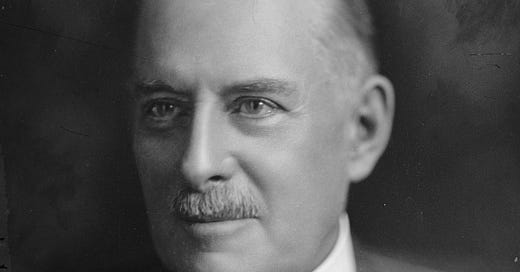Donald Trump might not know history. At least he’s given little evidence of such knowledge. But as the man who has fixed the name “Trump” on properties around the world and been well paid for doing so, the president understands the value of labels. His order to rename Alaska’s (and North America’s) tallest mountain, Denali, as Mount McKinley likely won’t have much lasting effect, besides annoying Alaskans. But his insistence on renaming the Gulf of Mexico as the Gulf of America just might.
Edward Taylor could have told him as much. Taylor entered Congress from western Colorado in 1909. He would serve seventeen terms until his death in 1941. Like everyone else on the Western Slope, Taylor was obsessed by water, always scarce in the region between the Sierra Nevada and the Rockies. Without water, the people of the region were poor and few. With water, they might become wealthy and numerous.
Schemes were already afoot to claim the water of the region. These were complicated by the several states and two countries through which the largest river of the American southwest, the Colorado, flowed. Taylor sought to ensure that his state received its due.
To his annoyance, a quirk of geographic nomenclature stood in the way. The lower reaches of the Colorado had been encountered by the Spanish centuries before anyone knew where its headwaters lay. They called it Rio Colorado — Red River — for the ochre mud it carried.
Other explorers had found the upper waters of the same river, without realizing it was the same one. They called it the Grand River, because it was the largest in the area and didn't have any other distinctive characteristic.
Not until the late 19th century did anyone demonstrate that the Grand River was a tributary of the Colorado River. When they did, they continued to employ the same names as before. The Grand River was so labeled from its headwaters in what is now Rocky Mountain National Park west to its confluence with the Green River in Utah. At that point the Grand and the Green combined to form the Colorado.
There was precedent for this kind of renaming at a major confluence. Above Pittsburgh, the principal tributaries of the Ohio River are called the Allegheny and Monongahela. Below Pittsburgh the combined river is called the Ohio.
The naming arrangement for the Colorado didn't much bother anyone before Edward Taylor. But Taylor, wishing to claim for Colorado as much of the river's water as possible, lobbied to rename the Grand River the Colorado. Residents and congressmen from Wyoming and Utah objected. Their Green River, they pointed out, drained a larger area than the Grand did. Taylor rejoined that the Grand, which he insisted on calling the Colorado, contributed more water than the Green.
Whether or not Taylor had the better argument, he had better connections than his counterparts from Wyoming and Utah. He persuaded Congress in 1921 to enact a statute formally renaming the Grand River the Colorado. In doing so he made Coloradans proud.
The following year he made them rich from the terms of the Colorado River Compact, which apportioned water from the river to seven southwestern states. Colorado got substantially more than its fair share. The compact divided the seven states into two groups, four states of the upper Colorado basin and three of the lower. Each group received roughly the same amount of water. Colorado got the lion's share of the upper basin water, almost as much as California, the largest of the lower-basin states and one with a much larger population than Colorado's.
Does Donald Trump know this story? Unlikely. But his instincts tell him that should a competition develop over resources in the body of water off the southern coast of the United States and the eastern coast of Mexico, America's negotiating position will only be bolstered by having that body called the Gulf of America.




Thank you for this interesting and informative article.
Excellent post as always: the Colorado River Compact, sounds really fascinating almost like something a evil genius would come up with. Professor can you recommend further reading on the Colorado River Compact? Do you write about it in more depth in “dreams of el dorado”?